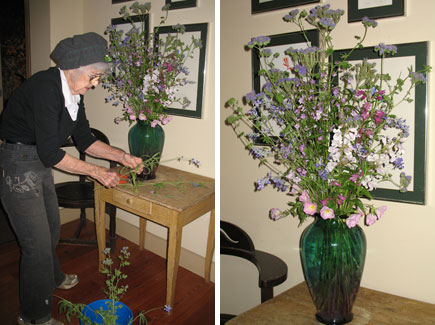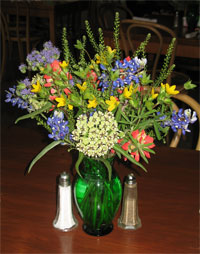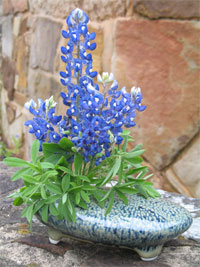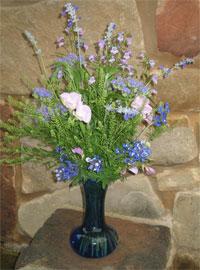Wild About Texas – April, 2010

Wanda Lancaster prepares mealy blue sage to add to an arrangement of pink evening primroses, penstemons, and blue curls. All photos by Andrea DeLong-Amaya.
Native Wildflowers for Cutting

Bouquet of antelope horns, Texas star, Texas or Indian paintbrush, blue curls, and peppergrass.

Texas bluebonnets, simply beautiful.

Bouquet of Texas bluebonnets, mealy blue sage, blue curls, pink evening primroses, Gulf penstemon and peppergrass.
I trust everyone is reveling in the exuberance of spring. The unseasonably cool weather and regular rains have made for fabulous gardening. The bluebonnets, native wisteria, wafer ash, and even the flowers on the mustang grape smell absolutely delicious! Cutting flowers for a table or windowsill is a great way to extend spring into the indoors, especially for those of us who spend most of our waking hours in offices.
Wanda Lancaster, a longtime volunteer for the Lady Bird Johnson Wildflower Center, heads up an intrepid crew of women who roam through fields, over streams, up cliff sides and into woods, foraging for flowers on their ranches, in gardens, and in other permitted areas. The haul is then prepared and arranged for various desks and tables throughout the Center for all to appreciate. I caught up with her today, and as Wanda picked leaves off of stems, I picked her brain.
When asked for her top picks for the vase, she chuckled that the list was too long and that just about anything that will hold up for a few days will work. (The list below is a sampling of some of the spring species she uses regularly). I can attest that “just about anything” has ended up in her compositions. Unlikely subjects such as grapevine, lichen-crusted tree bark, ball moss, and peppergrass have been represented. “Even the cones of purple coneflowers are great. We just pull off the old petals after they’ve faded,” she asserted.
Decades of professional and volunteer flower arranging have gifted her with an education she is enthusiastic to share: After making a cut in the field, remove any foliage that would be submerged in water to maintain good water quality. Immediately put the stem in clean water, and protect it from the sun and heat to the extent possible. Wait a day before arranging the cut stems to allow them to recover from any wilting they may suffer. If they don’t recover, don’t use them. She recommends Floralife Quick Dip flower hydrator to help with this problem, and fresh flower food to prolong vase life.
Following ethical and legal protocol is critical when you are not collecting from your own property. Think twice if you are harvesting from a small population or if you are tempted to take more than 10 percent of the stems in a given patch of flowers. And always obtain permission from landowners before collecting or setting foot on their soil.
Assembling cut flowers is a wonderfully edifying and experimental process. You get to enjoy the fresh outdoor air, stretch your legs, and implement floral combinations no one has ever seen in the wild. Oh yeah, and Mother’s Day is just around the corner!
Here is a list of some of the flowers illustrated in the photos:
Mealy blue sage (Salvia farinacea) — Spiky form; long stems.
Pink evening primrose (Oenothera speciosa) — Stems should be cut with unopened buds for a progression of flowers that can last up to a week. Flowers are large, and the soft pink blends well with other colors.
Bluebonnets (Lupinus texensis, other species) — Clear blue color and fragrant flowers; blooms early in the season; state flower of Texas.
Blue curls (Phacelia congesta) — Scorpioid flower stems uncurl as they bloom. Interesting form and soft blue color. Flowers shed a little.
Gulf penstemon (Penstemon tenuis, other species) — All penstemons are great in arrangements. They last a long time and feature soft pastel colors. Flowers shed a little.
Peppergrass (Lepidium virginicum) — Spiky form; great filler. Small, rounded seedpods offer contrasting texture.
Antelope horns (Asclepias asperula, other species) — Large balls of green flowers. Seedpods of all species offer great form. All species have milky sap; rinse them off after removing leaves before placing in the vase.
Texas star (Lindheimera texana) — Nice shade of gold; flowers early in season.
Indian paintbrush (Castilleja indivisa) — Lasts well; strong color contrast; brittle, so handle gently.
Giant spiderwort (Tradescantia gigantea) — Shades of purple, blue, lavender, pink, magenta, and white; lightly fragrant; blooms early in season and is abundant; slimy to handle. Flowers close in evening, so it’s best for daytime viewing.
As the spring progresses, add these reliable beauties:
Texas bluebells (Eustoma exaltatum) — Wanda’s favorite (and reportedly, Lady Bird’s, too) because they are huge, richly colored, and long-lasting, up to ten days.
Texas thistle (Circium texanum) – Lasts well; provides height; round flower form; very prickly, so wear gloves — it’s worth it!
Purple coneflower (Echinacea purpurea) — Lasts a long time; vibrant color. Once petals have faded, pull them off and use the “cone” in a new composition.
Grasses (any species) — Add height, texture, softness; great fillers; dry well if cut when still green. Wanda frequently uses inland sea oats, yellow Indiangrass, big muhly, switchgrass, and Virginia or Canada wild rye.
Big red sage (Salvia penstemonoides) — Flowers on long stems offer height; magenta color; flowers shed.
For more information about Texas native plants, visit the Wildflower Center’s website at www.wildflower.org.
About the author: Andrea DeLong-Amaya is the director of horticulture at the Lady Bird Johnson Wildflower Center in Austin.
